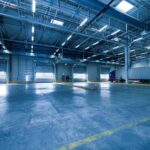Latest News Articles
Blog Post 2
Why we should Use LED

Large commercial and industrial spaces like factories, warehouses, universities, and hospitals (to name a few) require well-planned efficient lighting for high visibility. LEDs are a necessity!
LEDs provide excellent light production with drastically lower power usage (money saved!), and up to 50,000 life hours before needing replaced! Check out these awesome LED lighting options to maximize productivity in a commercial or industrial setting.
High Bay Fixtures
High bay fixtures are one of the best lighting options for open spaces with tall ceilings. We carry all types of high bay fixtures including traditional, linear, and UFO high bay fixtures.
This 200W UFO High Bay fixture by Hylumen produces 28,000 lumens making it a brilliant lighting solution for commercial spaces. This fixture also has an IP rating of 65, making it compatible for dusty and damp environments. Buyers have the selection between a colorless polycarbonate reflector or a shiny aluminum reflector. Available in 4000K and 5000K.
LED Flood Light
Flood lights are broad beamed lighting fixtures that emit high intensity artificial light. They are typically used in large and improperly lit commercial places as they flood the space with uniform illumination. According to the leading commercial lighting manufacturers, flood lights are vital for areas like shipyards, manufacturing plants, construction sites, parking lots, highways, open fields, etc. as these areas require proper illumination during operational hours.
Earlier, these respective spaces were illuminated with High Intensity Discharge (HID) lamps or Halogen flood lights. However, with the introduction of LEDs, the traditional lighting fixtures are gradually being replaced by outdoor LED flood lights by users and concerned authorities.
LED flood lights emit white light that beams out at a very broad angle. These lights have a higher lumen per watt output than other conventional lighting solutions and furnish multiple benefits and advantages for the users.
Here are 5 benefits that users can reap with the installation of LED flood lights and flood light fixtures:
Long Life
LED flood lights are strong, durable and long lasting. As per the top LED lighting manufacturers, LEDs last up to 10 times longer than other filament or gas-based lights and remain operational for almost 50,000 hours. This eliminates the hassle of replacing bulbs for an extended period of time which eventually reduces the overall maintenance costs.
Energy Efficient
Energy efficiency is one of the primary benefits of using LED flood lights. LED is a lighting technology that has revolutionized the whole commercial lighting domain. According to experts, they are one of the most competent electrical appliances that encourage sustainability and savings simultaneously.
Controlled Heat Emission
Since flood lights are one of the most powerful appliances of the lighting domain, they convert a vast amount of supplied energy into heat. This contributes to rise in temperature of the surrounding area and makes the appliances vulnerable to damage. However, LED floodlights limit heat emissions as they convert and conserve maximum amount of electricity. For instance, Alpha LED Floodlights by Wipro Lighting are integrated with active thermal management system that reduces heat emission considerably.
Environment-friendly
LED flood lights are free from various toxic elements. Unlike traditional lighting solutions, they don’t contain carbon, mercury, lead or glass. Thus, they are safe for the environment and for the users.
Cost-Efficient
Lastly, LED flood lights are highly cost-efficient as compared to HID lamps or halogen lights. Lesser electricity consumption, low maintenance costs, longer life, etc. are some of the factors that help users to save a considerable amount of money in the long run.
In addition, LED flood lights remain unaffected by weather changes and temperature fluctuations. They don’t emit heat, and thus, emerge as the safest lighting option.
How to Choose the Right LED Street or Area Light
LED Street and Area Lighting Fixtures are ideal for outdoor areas including streets, roadways, parking lots, and pedestrian areas.  Well-designed LED outdoor fixtures can provide the required surface illuminance using less energy and with improved uniformity. These LED Area Lights also have significantly longer life and offer better lumen maintenance, energy efficiency, durability, color quality, light distribution, thermal management, and low costs.
Well-designed LED outdoor fixtures can provide the required surface illuminance using less energy and with improved uniformity. These LED Area Lights also have significantly longer life and offer better lumen maintenance, energy efficiency, durability, color quality, light distribution, thermal management, and low costs.
When selecting an LED Area Light, you will want to consider the following options:
Mounts
LED Area Lights are available in different mounts such as pole mounted fixtures, slipfitter and trunnion mount models, knuckle pole and wall mounts. LED Area Lights also fit into commercial fixtures and shoebox fixtures which feature multiple mounting options, and a heavy duty slim design.
Lumens
With new light bulbs, shopping by lumens is more important than shopping by watts when choosing which energy-efficient bulb to purchase. While wattage measures the amount of energy required to light products, lumens measure the amount of light produced. This means that the more lumens the product has, the brighter the light source is. Instead of buying products based on how much energy they consume (watts), consumers should consider how much light they give us (lumens).
Wattage
Wattage is the measure of the bulb’s energy consumption – not how much light it puts out. Energy-efficient bulbs use fewer watts to give off the same amount of brightness (lumens). Because of this, LEDs (which have typically low wattages when compared with lumens) not only help reduce energy usage but also lower electric bills.
Color Temperature
Color temperature refers to the color appearance of the light that comes from a light source. It’s an important performance characteristic to asses when evaluating bulbs because the color temperature creates the mood of the space you are lighting and can thus influence buying behavior or work performance. The apparent color of a light source is measured in Kelvin. The higher the Kelvin temperature, the whiter the light.




